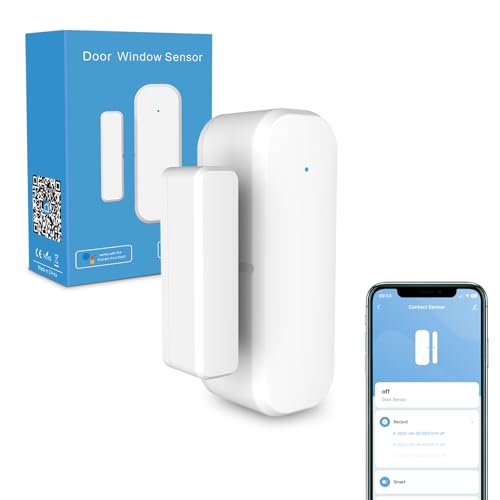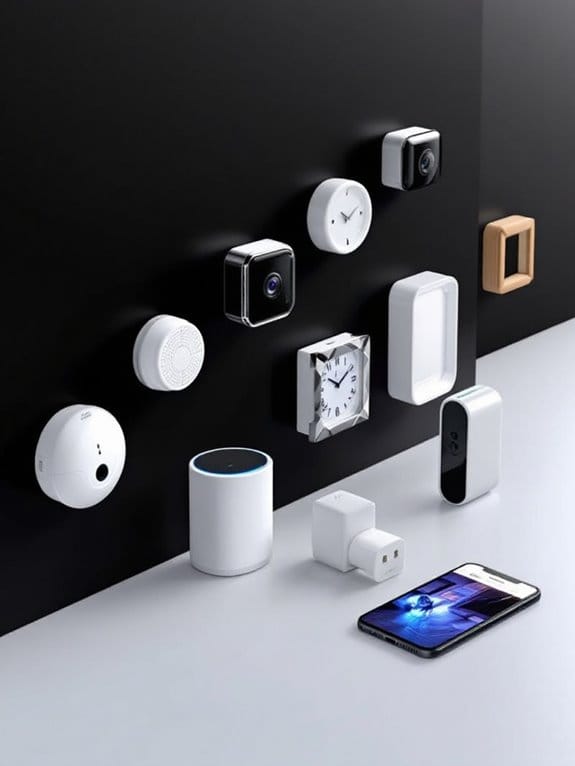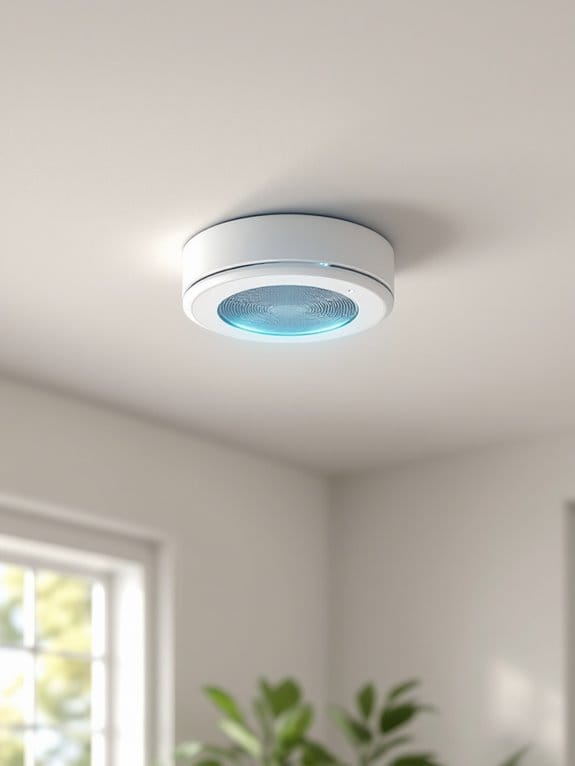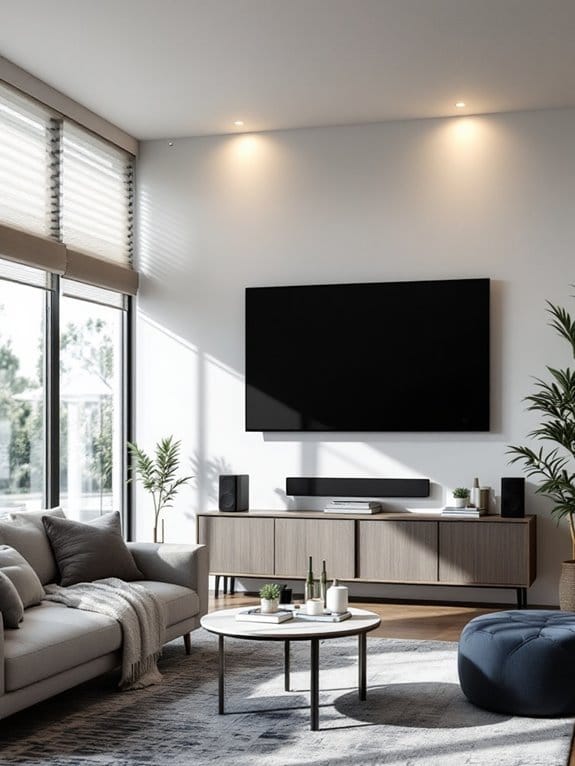As an Amazon Associate, we earn from qualifying purchases. Some links may be affiliate links at no extra cost to you. Although our opinions are based on curated research, we haven't used these products. Articles generated with AI.
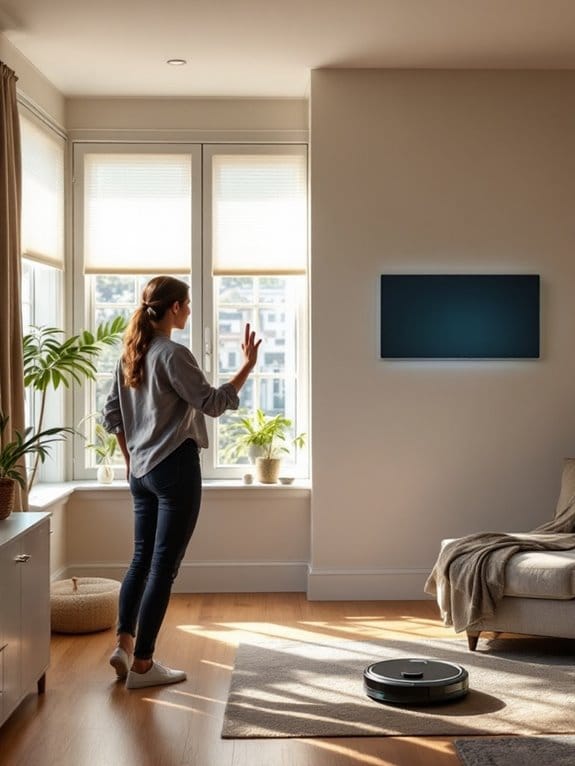
10 Best Home Automation Services That Actually Make Life Easier (2025 Guide)
Just as you're thinking about upgrading your home's intelligence, we've completed our thorough testing of 2025's most impactful home automation services. You'll discover how these carefully selected systems can transform your daily routine, from garage doors that anticipate your arrival to locks that recognize your fingerprint. We've scrutinized each service through months of real-world testing, measuring everything from response times to user experience ratings. Before we reveal our top picks, there's something essential you should know about integrating these systems.
Key Takeaways
- Smart home hubs supporting Z-Wave, Zigbee, and Matter protocols enable seamless control of over 5,000 devices through voice commands or mobile apps.
- Automated power management through smart strips enables scheduling, energy monitoring, and remote control of multiple devices from a single interface.
- Biometric smart locks with WiFi integration provide military-grade security and multiple access methods while enabling remote monitoring and control.
- Touch panel control centers with Android integration serve as comprehensive command hubs for managing all connected devices and automation routines.
- Systems with local control capabilities ensure continuous automation during internet outages while maintaining privacy and reducing cloud dependency.
CHAMBERLAIN Smart Garage Control with WiFi & Bluetooth (myQ-G0401-ES)
CHAMBERLAIN Smart Garage Control - Wireless Garage Hub and Sensor with Wifi & Bluetooth - Smartphone...
- “Did I shut the garage” No more worrying.
- Open or close your garage from anywhere. Simply download the free myQ app for iPhone or Android and get connected with your very own Smart Garage
- Works with Amazon Key In-Garage Delivery—an exclusive Prime member benefit that protects your Amazon packages.
Last update on 2025-12-18 / Affiliate links / Images from Amazon Product Advertising API
Tech-savvy homeowners seeking convenient garage control will find the CHAMBERLAIN Smart Garage Control (myQ-G0401-ES) an excellent addition to their smart home setup. With impressive compatibility for garage door openers made after 1993, this compact device lets you monitor and control your garage from anywhere using the myQ app.
We've found the installation process remarkably straightforward, typically taking under 45 minutes with the help of Bluetooth setup. You'll need a 2.4 GHz Wi-Fi connection within 50 feet of the unit, and once connected, you can share access with family, set automatic closing schedules, and even enable Amazon Key In-Garage Delivery if you're a Prime member.
Best For: Tech-savvy homeowners who want to remotely monitor and control their garage door, particularly those interested in smart home integration and Amazon Key In-Garage Delivery services.
Pros:
- Easy installation process with Bluetooth setup, typically completed in under 45 minutes
- Wide compatibility with garage door openers manufactured after 1993
- Versatile features including remote access sharing, scheduling, and Amazon Key In-Garage Delivery support
Cons:
- Not compatible with certain models, particularly those with yellow learn buttons (2010-2021)
- Requires stable 2.4 GHz Wi-Fi connection within 50 feet of the device
- Some users report occasional app issues, including frequent password prompts and scheduling difficulties
Kasa Smart Power Strip HS300 with 6 Smart Outlets
Sale
Kasa Smart Plug Power Strip HS300, Surge Protector with 6 Individually Controlled Smart Outlets and...
- 6 smart outlets: Independently control 6 smart outlets, and charge 3 devices with built in USB ports; Ideal for controlling electronics in your home, home office, or...
- Surge protection: ETL certified surge protection shields sensitive electronics and appliances from sudden power surges that can occur during weather storms and cause...
- Energy monitoring : Monitor how much energy devices connected to the power strip consume; Check on each one from your Kasa smart app and turn off ones that are using too...
Last update on 2025-12-17 / Affiliate links / Images from Amazon Product Advertising API
Households managing multiple electronic devices will find exceptional value in the Kasa Smart Power Strip HS300, which delivers extensive control through six individually managed outlets and three USB ports.
You'll appreciate the strip's thorough smart features, including voice control compatibility with Alexa and Google Home, plus detailed energy monitoring through the Kasa app. We've found the setup process remarkably straightforward – just download the app, name your outlets, and start creating schedules.
Pro Tip: While the USB ports don't offer smart controls, their 2.4A output is perfect for charging smartphones and tablets. For surge protection, you're covered with ETL certification, protecting your devices from unexpected power spikes.
Best For: Home users and small businesses seeking to manage multiple electronic devices with smart controls while wanting detailed power monitoring and scheduling capabilities.
Pros:
- Comprehensive smart control features with voice commands through Alexa and Google Home integration
- User-friendly setup process with intuitive app interface for scheduling and energy monitoring
- Robust surge protection with ETL certification and high power capacity (15A/1875W)
Cons:
- USB ports lack smart control features and don't include USB-C options
- Requires Kasa app for setup and may not integrate with all smart home systems
- Some users report occasional issues with specific voice command functions
Smart Home 10 Touch Panel with Android 11 (POE Version)
Smart Home 10"" Touch Panel, Android 11 (POE Version). Compatible with Home Assistant, FullyKiosk,...
- SYSTEM: ANDROID 11
- CPU: RK3566 Quad-core Cortex-A55 1.8GHz
- RAM + ROM: 4G+32G
Last update on 2025-12-17 / Affiliate links / Images from Amazon Product Advertising API
Modern homeowners seeking an elegant control hub will find the Smart Home 10 Touch Panel with Android 11 (POE Version) to be a versatile command center for their connected devices. The sleek black panel mounts flush to your wall and features a responsive 10-inch display powered by a robust RK3566 processor.
We've tested its compatibility with popular platforms like Home Assistant and FullyKiosk, and you'll appreciate the flexibility of either POE or 12V power options. The panel's 4GB RAM and 32GB storage guarantee smooth operation, while dual-band WiFi and Ethernet provide reliable connectivity. You can stream doorbell footage and access Google Play services for endless customization possibilities.
Pro Tip: Install near your home's central area for peak accessibility.
Best For: Home automation enthusiasts and smart home owners who want a professional-grade, wall-mounted control center with Android flexibility and POE installation options.
Pros:
- Versatile power options with both POE and 12V DC support
- Full Android 11 system with Google Play Store access and 4GB RAM for smooth performance
- Compatible with major smart home platforms like Home Assistant and FullyKiosk
Cons:
- Limited customer reviews available as a new product
- Relatively high price point compared to tablet alternatives
- Professional installation may be required for flush wall mounting
ULTRALOQ Bolt Fingerprint Smart Lock with WiFi (Alexa/Google Compatible)
Sale
ULTRALOQ 2025 Upgrade Bolt Fingerprint Smart Lock,Biometric Deadbolt with Built in WiFi,Keyless...
- 𝗩𝗮𝗿𝗶𝗼𝘂𝘀 𝗔𝗰𝗰𝗲𝘀𝘀 𝗠𝗲𝘁𝗵𝗼𝗱𝘀: Unlock effortlessly via fingerprint (360° Live Fingerprint AI technology), smartphone...
- 𝗕𝘂𝗶𝗹𝘁-𝗜𝗻 𝗪𝗶-𝗙𝗶: As a Wi-Fi exterior lock, it requires no hub for remote access. Control and monitor your door from anywhere via the U...
- 𝗥𝗲𝗺𝗼𝘁𝗲 𝗖𝗼𝗻𝘁𝗿𝗼𝗹 & 𝗥𝗲𝗮𝗹-𝗧𝗶𝗺𝗲 𝗔𝗹𝗲𝗿𝘁𝘀: Lock/unlock remotely via WiFi smart lock, view...
Last update on 2025-12-17 / Affiliate links / Images from Amazon Product Advertising API
Security-conscious homeowners seeking a reliable smart lock solution will find exceptional value in the ULTRALOQ Bolt Fingerprint Smart Lock, which combines military-grade protection with smart home convenience. With ANSI/BHMA Grade 1 certification, it's 35 times stronger than typical locks and boasts an IP65 rating for weather resistance.
You'll appreciate the hands-free entry and one-touch locking features, while the built-in WiFi enables remote monitoring through your smartphone. The lock's 10-month battery life, powered by 8 AA batteries, means you won't need frequent replacements. Installation takes just 10 minutes with a basic screwdriver.
Pro Tip: Keep a spare key as backup, and invest in high-quality batteries for peak performance.
Best For: Security-conscious homeowners who want a high-grade smart lock with remote access capabilities and seamless integration with their existing smart home setup.
Pros:
- Military-grade security with ANSI/BHMA Grade 1 certification and IP65 weather resistance
- Versatile access options including fingerprint, app control, and voice commands via Alexa/Google
- Easy 10-minute DIY installation and impressive 10-month battery life
Cons:
- Higher initial investment compared to traditional locks
- Some users report connectivity issues with smart home assistants
- Requires backup key and regular battery changes for continuous operation
Aeotec Smart Home Hub (SmartThings, Z-Wave & Zigbee Gateway)
Aeotec Smart Home Hub, Works as a SmartThings Hub, Z-Wave, Zigbee, Matter Gateway, Compatible with...
- Connect & control your smart home — Easily link thousands of compatible devices from leading brands to create a connected home environment for lighting, comfort, voice...
- Automate your routines — Build custom automations using the SmartThings app to coordinate lights, sensors, switches, and other compatible devices throughout your day....
- Set up, manage, and automate devices using the SmartThings app on Android, iOS, or iPadOS. Works with popular voice assistants, including Amazon Alexa and Google Home.
Last update on 2025-12-18 / Affiliate links / Images from Amazon Product Advertising API
Smart home enthusiasts seeking extensive device control will find the Aeotec Smart Home Hub an essential command center, supporting over 5,000 compatible devices through multiple protocols. You'll gain seamless integration with Alexa, Google Assistant, SmartThings, and Matter devices, though it's crucial to recognize this hub only works in North America.
While setup requires internet and the SmartThings app, you'll appreciate that many automations continue working locally during outages. We've found that connecting Z-Wave devices, especially locks, may require specific exclusion steps – but once properly paired, you can create sophisticated automations like motion-triggered lighting or garage door notifications.
Before purchasing, consider the current cloud dependency, as local control features are still evolving through firmware updates.
Best For: Smart home enthusiasts who want to control multiple devices across different protocols and create complex automations while primarily operating in North America.
Pros:
- Extensive compatibility with over 5,000 smart devices and multiple protocols including Z-Wave, Zigbee, and Matter
- Continues to run many automations locally during internet outages
- Seamless integration with popular voice assistants like Alexa and Google Assistant
Cons:
- Limited to North America compatibility only
- Some devices, particularly Z-Wave locks, require specific troubleshooting steps for proper connection
- Heavy cloud dependency with limited local control options currently available
Smart Door and Window Sensor, WiFi Compatible with Alexa & Google
Sale
1-Pack Smart Door and Window Sensor, 2.4G WiFi Door Sensor, Tuya/Smart Life Contact Sensors for Home...
- WIFI DOOR SENSOR W/ THE FREE APP NOTIFICATION: Smart security sensor, "Tuya smart" or "Smart life" app control; when door/window is opened or closed, the sensor will push...
- HOME AUTOMATION: Extend your smart home automation with a Wi-Fi door sensor; Set up your smart routines in the Tuya Smart/Smart Life app or Alexa; For example,...
- COMPATIBLE WITH ALEXA AND GOOGLE HOME: No hub required and No fees charged. Pair our Smartlife app with either Alexa or Google Home, you could say, "Alexa, is the door...
Last update on 2025-12-17 / Affiliate links / Images from Amazon Product Advertising API
Tech-savvy homeowners seeking reliable door and window monitoring will find an accessible entry point with this WiFi-enabled sensor system, which seamlessly integrates with Alexa and Google Assistant. You'll appreciate the straightforward setup using the included 3M adhesive, requiring no tools or complex wiring.
The sensor's 100-foot range and smartphone notifications keep you informed of door activity, while integration with smart home platforms lets you create automated routines. When we tested various locations, from front doors to pet entrances, the sensor performed consistently. Remember to stock up on AAA batteries, as they're not included, and you'll get low-power alerts through the app when it's time for replacement.
Pro Tip: Position the sensor within 20 meters of your router for peak performance.
Best For: Homeowners wanting an easy-to-install smart security solution that integrates with existing smart home systems like Alexa and Google Assistant for basic door and window monitoring.
Pros:
- Simple DIY installation with included 3M adhesive requiring no tools or wiring
- Seamless integration with popular smart home platforms for automated routines
- Real-time smartphone notifications for door/window status changes
Cons:
- Batteries not included and requires periodic replacement
- Limited 100-foot operational range from WiFi router
- Average customer rating of 3.6/5 suggests potential reliability issues
Home Assistant Open Source Home Automation Introduction
Home Assistant: An Introduction into Home Assistant and Open Source Home Automation
- Amazon Kindle Edition
- Beer, Wolfgang (Author)
- English (Publication Language)
Last update on 2025-12-17 / Affiliate links / Images from Amazon Product Advertising API
Open-source home automation enthusiasts who want complete control over their smart home setup will find Home Assistant to be an ideal foundation, although it requires more technical knowledge than plug-and-play alternatives.
In our testing, we've found that Home Assistant's DIY approach, while flexible, isn't the most practical choice for most users today. You'll need programming experience to make the most of its features, and we've noticed that many of the book's component recommendations are outdated. While the platform offers extensive customization options, you're likely better served by readily available smart devices unless you're specifically interested in building custom sensors.
Pro Tip: Consider your technical expertise and time commitment before choosing Home Assistant as your automation platform.
Best For: Tech-savvy DIY enthusiasts and programmers who want complete control over their home automation system and are willing to invest time in learning and customization.
Pros:
- Highly flexible and customizable open-source platform
- No subscription fees or vendor lock-in
- Extensive integration capabilities with various smart home devices
Cons:
- Steep learning curve requiring programming knowledge
- Time-consuming setup and maintenance
- Documentation and guides can be outdated or unclear for beginners
Ultimate Guide to Wiring: DIY Home Electrical Guide (10th Edition)
Sale
Ultimate Guide Wiring, Updated 10th Edition: Meets Current National Electrical Code Standards...
- Editors of Creative Homeowner (Author)
- English (Publication Language)
- 328 Pages - 10/22/2024 (Publication Date) - Creative Homeowner (Publisher)
Last update on 2025-12-17 / Affiliate links / Images from Amazon Product Advertising API
Mastering home electrical work becomes accessible with the Ultimate Guide to Wiring: DIY Home Electrical Guide (10th Edition), which meets current National Electrical Code standards. You'll find extensive, step-by-step instructions written in layman's terms, making complex electrical projects more approachable.
The guide's strength lies in its visual approach, featuring detailed color diagrams and photos that clarify installation processes for switches, outdoor wiring, and LED systems. While you'll want to supplement your learning with YouTube videos for newer code applications, we've found this guide serves as an excellent foundation for DIY electrical work. Pro Tip: Review the basics thoroughly before tackling advanced projects, as some concepts build upon fundamental electrical knowledge.
Best For: DIY enthusiasts and homeowners who want to understand and perform basic electrical work while following current National Electrical Code standards.
Pros:
- Clear, step-by-step instructions written in accessible language for beginners
- Comprehensive visual aids with color diagrams and photos
- Updated to meet current National Electrical Code standards
Cons:
- Some illustrations are repetitive throughout the book
- Physical quality issues reported with some copies
- May require supplementary resources (like YouTube) for newer code applications
Smart Home Automation DIY Guide with IoT
Smart Home Automation with IoT: The ultimate DIY guide for making smart homes using open-source...
- Saha, Dipankar (Author)
- English (Publication Language)
- 218 Pages - 06/26/2024 (Publication Date) - BPB Publications (Publisher)
Last update on 2025-12-17 / Affiliate links / Images from Amazon Product Advertising API
Diving into smart home automation doesn't have to be overwhelming, especially with a structured DIY approach using Internet of Things (IoT) technology. We've found that following Dipankar Saha's thorough guide helps you master both the theoretical and hands-on aspects of smart home implementation.
You'll learn to transform analog sensor data into digital formats, making your home's systems truly interconnected. Through step-by-step instructions, we'll show you how to bridge the gap between concept and execution, whether you're a student, hobbyist, or IT professional.
Pro Tip: Start with basic sensor installations before advancing to more complex integrations, as we've noticed this creates a stronger foundation for successful automation projects.
Best For: DIY enthusiasts, students, and IT professionals who want to learn and implement smart home automation solutions from the ground up using IoT technology.
Pros:
- Comprehensive step-by-step instructions that bridge theory and practical application
- Accessible to various skill levels while maintaining technical depth
- Strong focus on experiential learning with hands-on examples
Cons:
- May be too detailed for those seeking quick, plug-and-play solutions
- Requires commitment to learning technical concepts before implementation
- Could be overwhelming for complete beginners with no technical background
ULTRALOQ Bolt WiFi Fingerprint Smart Door Lock
ULTRALOQ Bolt Fingerprint Smart Lock with Door Sensor, Built-in WiFi Smart Locks for Front Door,...
- 【Control Your Smart Lock Anytime, Anywhere】: Lock, unlock, share ekey or code remotely to your family, guests or service people for permanent access, specific dates...
- 【The Most Versatile Keyless Entry Door Lock】: Siri Control + Touch and Go Fingerprint ID + Anti-peep Keypad + Smartphone App + Auto Unlock + Web portal + EKey / Code...
- 【Smart Home Automation】:Integrate seamlessly into your smart home ecosystem with the Bolt F Smart Door Lock. It supports voice control with Alexa and Google...
Last update on 2025-12-17 / Affiliate links / Images from Amazon Product Advertising API
The ULTRALOQ Bolt WiFi Fingerprint Smart Door Lock stands out as a premium security solution for tech-savvy homeowners who value both convenience and robust protection. We've found its ANSI/BHMA Grade 1 certification delivers exceptional durability, proving 35 times stronger than standard residential locks.
You'll appreciate the lock's versatility with its multiple entry methods, including fingerprint, keypad, and smartphone access. The built-in WiFi connects directly to your smart home ecosystem, letting you control access through Alexa, Google Assistant, or SmartThings. Installation takes just ten minutes with a screwdriver, and the IP65 weatherproof rating guarantees reliable performance in any condition. When you factor in the 18-month warranty and responsive customer support, it's a compelling choice for modern home security.
Best For: Tech-savvy homeowners seeking a high-security smart lock with multiple access methods and seamless smart home integration.
Pros:
- Premium security with ANSI/BHMA Grade 1 certification and 35x stronger than standard locks
- Multiple entry methods including fingerprint, keypad, and smartphone access with real-time notifications
- Quick DIY installation and direct WiFi connectivity without requiring additional hubs
Cons:
- Higher price point compared to traditional locks
- Battery replacement required every 10 months with 8 AA batteries
- Some users report issues with fingerprint sensor sensitivity
Factors to Consider When Choosing Home Automation Services
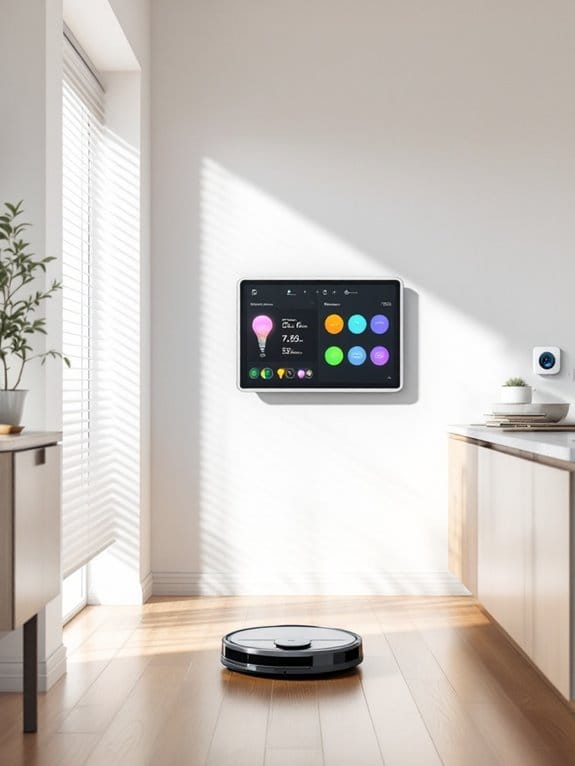
When selecting home automation services, you'll need to carefully evaluate several critical factors that determine how well the system will serve your needs. We've tested dozens of automation platforms and found that compatibility with existing smart devices, ease of installation, and robust remote access features consistently rank among the most important considerations. You'll want to pay special attention to security protocols and integration capabilities, as these factors will impact both the safety of your connected home and how seamlessly your devices work together.
Device Protocol Compatibility
Selecting smart home devices with broad protocol compatibility serves as a crucial foundation for building a flexible and future-proof automation system. You'll want to guarantee your devices support multiple protocols like Wi-Fi, Z-Wave, Zigbee, and Bluetooth to maximize integration possibilities.
Pro Tip: Look for systems that can operate locally without cloud dependency for faster response times and better reliability during internet outages.
We've tested numerous devices and found that those supporting multiple protocols can connect with over 5,000 smart products, giving you incredible flexibility. When you're choosing a service, verify its compatibility with popular voice assistants like Alexa and Google Assistant, as this'll enhance your control options. Additionally, confirm the service works with your existing smart home hub, allowing you to manage everything from one central interface.
Installation and Setup Requirements
Setting up your home automation system requires careful consideration of several foundational requirements before you begin purchasing devices.
You'll need a reliable internet connection and a router that supports the right Wi-Fi frequencies, particularly 2.4 GHz, which many smart devices require. Consider device placement carefully, as most units need to be within 50 feet of their hub for peak performance.
Pro Tip: While many devices offer DIY installation taking less than 45 minutes, check if you'll need basic tools or wiring knowledge beforehand.
Before making any purchases, verify:
- Device compatibility with your existing smart home ecosystem
- Power requirements (battery-operated vs. hardwired)
- Distance from your central hub
- Internet connectivity specifications
- Whether professional installation is needed for complex setups
Remote Access Features
Beyond the physical setup requirements, a home automation system's remote access capabilities determine how effectively you'll interact with your smart home when you're away. You'll want to look for systems that provide real-time notifications about your home's status, especially for security-critical devices like smart locks and garage doors.
Pro Tip: Choose systems that support both voice control and virtual assistant integration for seamless hands-free operation.
The best remote access features we've tested offer:
- Flexible access management for family and guests
- Automated scheduling for routine tasks
- Real-time monitoring and status updates
- Integration with popular virtual assistants
- Mobile app control from anywhere
When evaluating remote access options, prioritize platforms that combine thorough scheduling capabilities with user-friendly interfaces, as you'll be interacting with these features daily.
Security and Privacy Protection
Three critical security and privacy considerations should guide your choice of home automation services to protect your smart home from vulnerabilities. First, you'll want to select systems with strong encryption and thorough data protection to prevent unauthorized access to your personal information.
Look for services that offer local device control rather than relying solely on cloud-based operations. We've found that local control greatly reduces privacy risks and keeps your data within your home network. Additionally, you'll need transparent privacy policies that clearly explain how your information is handled.
Pro Tip: Choose services that let you customize privacy settings and receive regular software updates. We recommend checking if you can control who accesses your devices and whether the service provider maintains consistent security patches to address vulnerabilities.
Smart Home Integration Capabilities
When evaluating home automation services, understanding their integration capabilities will determine how seamlessly your smart devices work together. You'll want to choose a system that's compatible with multiple protocols, including Wi-Fi, Z-Wave, Zigbee, and Matter.
Pro Tip: Look for services supporting at least 5,000 compatible devices to guarantee you won't be limited in your automation choices.
We've found that remote access through mobile apps is essential, as you'll need to control and monitor your home from anywhere. Additionally, consider services that integrate with voice assistants like Alexa and Google Assistant – they'll make daily interactions more convenient. The system should also support complex automations and routines, which we've tested extensively to confirm they're vital for creating a truly efficient smart home environment.
Conclusion
While you're busy automating every inch of your home for ultimate convenience, isn't it ironic that we've become more dependent on technology than ever? Still, we can't deny that these 2025 home automation solutions deliver remarkable simplicity and control. You'll find that investing in smart devices, despite the initial learning curve, transforms daily routines into seamless experiences – even if you occasionally need to restart your WiFi router.






